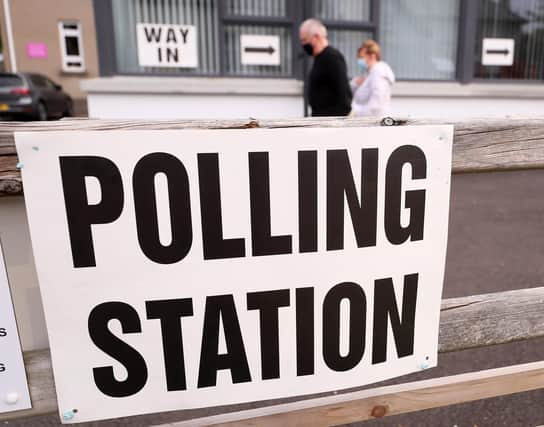John Coulter: Unionists should ditch liberalism and push for mandatory voting


My late parents and grandparents were members of the Ulster Unionist Party. I joined the North Antrim Young Unionists in 1977 as a teenager. If last year’s assembly poll made grim reading, then the council election outcome was the political equivalent of a slasher horror movie script.
But the most bitter medicine was watching the results of the council elections with the UUP by far runners-up to the DUP in terms of seats. While the DUP held its ground even though the party ran fewer candidates than in 2019, the pro-Union family is once again playing second fiddle politically to the Provisional IRA’s political wing, Sinn Fein. In footballing terms, Sinn Fein ‘played a blinder’ in the council poll, delivering a double whammy to unionism. Last year, Sinn Fein became the largest party at Stormont. Now, Sinn Fein has the largest number of councillors across Northern Ireland’s 11 councils.
Advertisement
Hide AdAdvertisement
Hide AdUnionism can take cold comfort from the fact the moderate nationalist SDLP also took a massive hit in the council elections. Alliance’s surge may have spluttered since the assembly showdown, but the Pan Nationalist Front of the republican movement and Alliance, and even the SDLP, was the big winner.
The real question for me is not how to combat the rapid rise of Sinn Fein who scored its best electoral victory since the 1918 Westminster General Election when the movement won around 70 of the 105 Commons seats when Ireland was entirely an integral part of the United Kingdom. My key question is – where now unionism, and specifically, where now for the UUP? What is certain is that a realignment is needed before the next Westminster general election, expected in 2024. Strangford UUP MLA Mike Nesbitt, a former party leader, has suggested the realignment could be two unionist parties – one liberal and the other traditional. Ironically, it was Nesbitt during his time as leader suggested the disastrous ‘Vote Mike, Get Colum’ policy aimed at encouraging unionists to give their other preference to the SDLP! That was as politically sensible for the UUP as an ash tray on a motorbike! Others have suggested a merger between the UUP and DUP. Others also want to see a single unionist party to represent all shades of pro-Union thinking. Realistically, could we unionists ever see a day when the UUP, DUP, TUV, PUP and independent unionists all come together under one banner simply called The Unionist Party? But who would lead such a united, merged unionist movement? Do we have too many chiefs with big political egos for such a concept to work? Is there too much distrust between DUP Paisleyites and life-long UUP diehards for the merger to work? Maybe unionists of my vintage point to the original Unionist Party which ruled the Stormont Parliament until it was prorogued in 1972?
Then, there was one single Unionist Party with a series of pressure groups. The right wing had the Ulster Monday Club; socialists had the Unionist Labour group; west of the River Bann had the West Ulster Unionist Council; there was also the Young Unionists for the youth, and the Ulster Unionist Women’s group. Even the Orange Order had delegates on the ruling Ulster Unionist Council. Sounded good on paper, until a certain Rev Ian Paisley was able to use his Protestant Unionist movement and fundamentalist Free Presbyterian Church of Ulster to clearly point out that the then Unionist Party had no voice for the loyalist working class or evangelical Christians.
The latest Nesbitt solution of a two-party realignment sounds more like a rebranding of the Sunningdale era of the 1970s when liberal unionists were part of the so-called called Pro-Assembly Unionists, and everyone else was part of the so-called ‘Treble UC’, also known as the United Ulster Unionist Coalition (UUUC).
Advertisement
Hide AdAdvertisement
Hide AdThe Pro-Assembly Unionists went on to form the now defunct liberal Unionist Party of Northern Ireland, once fronted by former Northern Ireland Prime Minister Brian Faulkner. The UUUC represented four unionist parties – UUP, DUP, Vanguard Unionists, and United Ulster Unionist Party – who carved up Northern Ireland’s constituencies between them, sweeping up all before them in 1974 with the exception of SDLP founder Gerry Fitt’s (later Lord Fitt) West Belfast bolthole. In reality, the so-called liberal progressive agenda has run its course. Ideologically, it needs to be dumped. What is now needed is a new Unionist Coalition of the Right constitutionally with a clear agenda to campaign for Australian-style mandatory voting.
A major plank in Sinn Fein becoming top dog at both Stormont and across the 11 Northern Ireland councils is that the republican movement got its vote out. In many pro-Union council areas, the turnouts dipped below 50%. Irish Unity could become a reality by default!
In many Australian elections, voter turnout usually always exceeds 90%. Perhaps the pro-Union parties should take a leaf out of the civil rights movement in the United States during the 1960s when there was a massive campaign to get African-Americans to get registered to vote, and come out to vote.
Until mandatory voting becomes an electoral reality in the long-term, in the short-term the unionist parties need to focus on persuading the ‘stay at home’ pro-Union community to not just get on the electoral register, but also to come to the polling stations to vote!
Advertisement
Hide AdAdvertisement
Hide AdUnionism’s biggest problem is not the DUP’s Stormont boycott or even mixed messages – its voter apathy. Unionist leaders can mouth off about unionist unity until the cows come home; in reality, the unionist parties need to embark on a massive mobilisation campaign in the pro-Union campaign. It’s also a campaign which the Christian Churches in Northern Ireland also need to support.
• Dr John Coulter has been a journalist since 1978, including with this newspaper